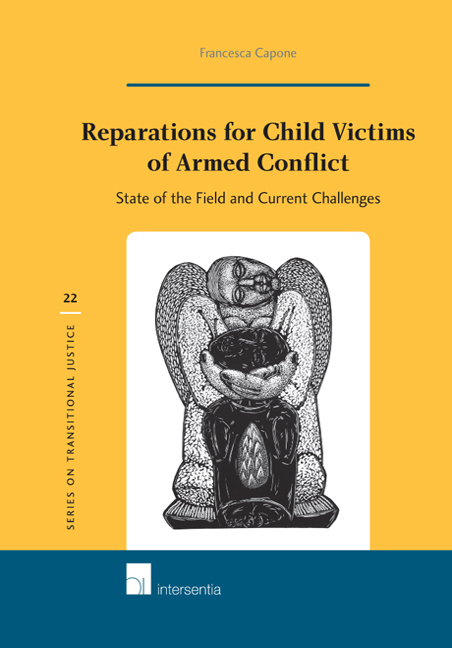Book contents
- Frontmatter
- Dedication
- Foreword
- About the Author
- Acknowledgements
- Contents
- Table of Cases
- Table of International Instruments
- List of Abbreviations
- Chapter 1 Setting the Scene
- PART I THE NORMATIVE AND THEORETICAL FRAMEWORK
- PART II CURRENT APPLICATION OF THE PRINCIPLES AND NORMS
- Chapter 5 Child Victims’ Right to Reparation in ‘Quasi-Judicial’ and Judicial International Settings
- Chapter 6 Child Victims’ Right to Reparation in ‘Quasi-Judicial’ and Judicial Regional Settings
- Chapter 7 Child Victims’ Right to Reparation in Non-Judicial Settings
- Chapter 8 Final Remarks
- Bibliography
- Index
Chapter 6 - Child Victims’ Right to Reparation in ‘Quasi-Judicial’ and Judicial Regional Settings
from PART II - CURRENT APPLICATION OF THE PRINCIPLES AND NORMS
Published online by Cambridge University Press: 29 September 2018
- Frontmatter
- Dedication
- Foreword
- About the Author
- Acknowledgements
- Contents
- Table of Cases
- Table of International Instruments
- List of Abbreviations
- Chapter 1 Setting the Scene
- PART I THE NORMATIVE AND THEORETICAL FRAMEWORK
- PART II CURRENT APPLICATION OF THE PRINCIPLES AND NORMS
- Chapter 5 Child Victims’ Right to Reparation in ‘Quasi-Judicial’ and Judicial International Settings
- Chapter 6 Child Victims’ Right to Reparation in ‘Quasi-Judicial’ and Judicial Regional Settings
- Chapter 7 Child Victims’ Right to Reparation in Non-Judicial Settings
- Chapter 8 Final Remarks
- Bibliography
- Index
Summary
INTRODUCTION
Regional human rights systems play a crucial role in strengthening IHRL. Initial concerns that regional systems could undermine the universality of human rights law have been surmounted in light of the important results achieved. In particular regional human rights systems provide a significant layer of protection, they can be more effective than UN bodies as they are closely connected to political regional developments and they have largely contributed, especially through their jurisprudence, to the enhancement of IHRL. In the field of reparations the Inter-American Commission and the Inter-American Court have paved the way to all the major developments, also in cases affecting children. The African human rights system, and in particular the African Committee of Experts on the Rights of the Child, the African Commission and Court on Human Rights and People's Rights, will be also analysed as the African continent is the most affected by violations of children's rights in armed conflict. The European human rights system will not be included in this overview because it has not dealt wiThthe impact of armed conflict on children.
THE AFRICAN HUMAN RIGHTS SYSTEM
The protection of human rights in Africa is monitored not only by the UN system, but also by a complex framework of regional instruments adopted by the Organisation of African Unity and its successor, i.e. the African Union (‘ AU’). The African human rights system includes not only the regional framework wiThthe ACtHPR and the African Commission on Human and Peoples ‘Rights, but also sub-regional organisations like the Economic Community of West African States (’ ECOWAS’), the East Africa Community (‘ EAC’) and the Southern African Development Community (‘ SADC’). The African Charter on Human and People's Rights entered into force in 1986 and has now been ratified by all 53 Member States of the AU, except for SouThSudan.
- Type
- Chapter
- Information
- Reparations for Child Victims of Armed ConflictState of the Field and Current Challenges, pp. 183 - 208Publisher: IntersentiaPrint publication year: 2017



